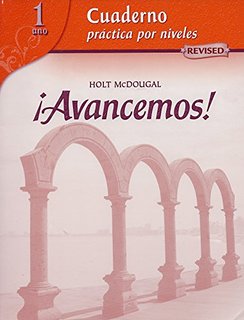
All Solutions
Page 373: Gramatica A
Remember that there are three levels of demonstration adjectives in Spanish:
1. the ones that refer to things that are **near** *(este/esta/esto – this* and *estos/estas – these*)
2. the ones that refer to things that are **far** *(ese/esa/eso – that* and *esos/esas – those)*
3. the ones that refer to things that are **very far** *(aquel/aquella/aquello – that over there* and *aquellos/aquellas – those over there)*
Also, in Spanish, you have to match the demonstration adjective with the noun’s number and gender.
**Estos** caballos…
*(**These** horses are very tall.)*
*”Caballos”* is a masculine noun in plural, so the demonstrative adjective has *”-os*” at the end.
*”Estos”* implies the horses are near.
**Aquellas** personas…
*(**Those people over there** are camping near the park.)*
*”Personas”* is a feminine noun in plural, so the demonstrative adjective has *”-as*” at the end.
*”Aquellas”* means that the people are very far.
**Esos** collares…
*(I like **those** necklaces a lot.)*
*”Collares”* is a masculine noun in plural, so the demonstrative adjective has *”-os*” at the end.
*”Esos”* means that they are far.
**Este** anillo…
*(**This** is Carolina’s ring.)*
*”Anillo”* is a masculine noun in singular, so the demonstrative adjective is *”este.”*
*”Este”* implies the object is near.
**Estos** recuerdos…
*(**These** souvenirs are for my family.)*
*”Recuerdos”* is a masculine noun in plural, therefore, the demonstrative adjective has *”-os*” at the end.
*”Estos”* implies the souvenirs are near.
**Aquel** perro…
*(**That dog over there** belongs to that guy.)*
*”Perro”* is a masculine noun in singular and the demonstration adjective is *”aquel.”*
*”Aquel”* means that the dog is very far.
1. X
2.
3.
4. X
5. X
6.
**Hint:** Look at the noun. Demonstration adjectives match with the noun’s number and gender.
*(I like to camp in this place.)*
*”Lugar”* is a masculine noun in singular, so the appropriate demonstrative adjective would be *”este.”* For masculine gender nouns we use the *”-e”* ending.
*(These earrings are very expensive.)*
*”Aretes”* is a masculine noun in plural, so the demonstrative adjective has *”-os*” at the end.
*(How much do these wooden handicrafts cost?)*
*”Artesanías”* is a feminine noun in plural, so the appropriate demonstrative adjective gets the *”-as”* ending.
*(Last week we had barbecue. That barbecue was very fun.)*
“Parrillada” is a feminine noun in singular, so the appropriate demonstrative adjective is *”esa.”* For feminine gender nouns we use the *”-a”* ending.
*(The quality of that ring over there is very good.)*
*”Anillo”* is a masculine noun in singular, so the appropriate demonstrative adjective would be *”aquel.”*
1. este
2. Estos
3. estas
4. Esa
5. aquel
You should answer the questions below. Use the answers below as a reference.
– En estas vacaciones, voy a ir a aquella playa que fui el año pasado.
*(For this vacation, I am going to that beach I went to last year.)*
*”Vacaciones”* is a feminine noun in plural, so we used the demonstrative adjective for feminine nouns in the plural, which is *”estas.”*
*”Playa”* is a feminine noun in singular, so the demonstrative adjective we used here is *”aquella.”* *”Aquella”* implies that the beach is very far; we have to travel to get to it.
– Compré esa cerámica en un mercado.
*(I bought that ceramic at the market.)*
*”Carámica”* is a feminine noun in singular, so we used the demonstrative adjective *”esa.”*
– No, esa cerámica fue cara.
*(No, that ceramic was expensive.)*
*”Carámica”* is a feminine noun in singular, so we used the demonstrative adjective *”esa.”*

